
MIDI is a technical standard that describes a communications protocol, digital interface, and electrical connectors that connect a wide variety of electronic musical instruments, computers, and related audio devices for playing, editing, and recording music. The specification originates in the paper Universal Synthesizer Interface published by Dave Smith and Chet Wood of Sequential Circuits at the 1981 Audio Engineering Society conference in New York City.
A music workstation is an electronic musical instrument providing the facilities of:

The Roland D-50 is a synthesizer produced by Roland and released in April 1987. Its features include subtractive synthesis, on-board effects, a joystick for data manipulation, and an analogue synthesis-styled layout design. The external Roland PG-1000 (1987-1990) programmer could also be attached to the D-50 for more complex manipulation of its sounds. It was also produced in a rack-mount variant design, the D-550 (1987-1990), with almost 450 user-adjustable parameters.
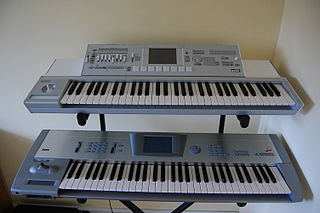
The Korg Triton is a music workstation synthesizer, featuring digital sampling and sequencing, released in 1999. It uses Korg's HI Synthesis tone generator and was eventually available in several model variants with numerous upgrade options. The Triton became renowned as a benchmark of keyboard technology, and has been widely featured in music videos and live concerts. At the NAMM 2007, Korg announced the Korg M3 as its successor.
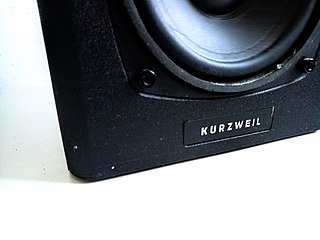
Kurzweil Music Systems is an American company that produces electronic musical instruments. It was founded in 1982 by Stevie Wonder (musician), Ray Kurzweil (innovator) and Bruce Cichowlas.
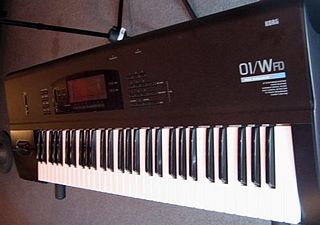
The Korg 01/W is a workstation synthesizer, released in 1991, and was intended to replace the M1 and T series. The workstation/ROMpler was based on AI², an improved version of the AI Synthesis technology found in the M1. The success of the AI² architecture ensured it was used in the majority of subsequent Korg synths of the 1990s.

The Yamaha Motif is a series of music workstation synthesizers, first released by Yamaha Corporation in August 2001. The Motif replaced the EX series in Yamaha's line-up and was also based on the early Yamaha S series. Other workstations in the same class are the Korg Kronos and the Roland Fantom G. The series' successor is Yamaha Montage.

The discontinued Roland MC-909 Sampling Groovebox combines the features of a synthesizer, sequencer, and sampler, with extensive hands-on control of both the sound engine and the sequencing flow. It was intended primarily for live performance of pre-programmed patterns consisting of up to 16 tracks of MIDI data. It was released by Roland Corporation on October 8, 2002. This product was announced at the AES Fall Convention in 2002. It is the direct successor to the Roland MC-505 and is the predecessor to the Roland MC-808. Which eventually ended the "Groovebox by year 2010" line of products by Roland which began in the year 1996 with the Original Roland MC-303 groovebox. The Roland Groovebox began again resurgence in the year 2019 with a two new modern & redesign Roland MC-707 GROOVEBOX/Roland MC-101 GROOVEBOX. The Roland MC-909 was developed from the blueprint of Roland's own "Roland Fantom-S Workstation & Roland Fantom-X Workstation" and uses the same structure and operating system, with some differences regarding the Patterns section, not implemented in the Roland Fantom S/X6/X7/X8 Workstation.

The Roland XP-30 is a 61-key, 64-voice expandable synthesizer. Released in 1999, it was produced until 2002. Based on the acclaimed mid-90s JV sound engine built around a 32-bit RISC processor, it is considered to be the best value-for-money of all of the Roland JV and XP series synthesizers.
The Fantom-X (Xa/X6/X7/X8/XR) is a music workstation/synthesizer produced by Roland Corporation. It was introduced in 2004 as an upgrade from the Fantom S series. The Fantom-X competes with the Korg Triton/Triton Extreme, the Yamaha Motif ES and other similar large-scope keyboards such as the discontinued Alesis Fusion. In 2008 it was succeeded by the Fantom-G*, which was devised to compete with the new Korg and Yamaha flagship keyboards.
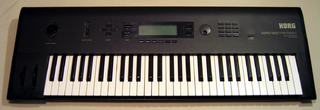
The Korg Wavestation is a vector synthesis synthesizer first produced in the early 1990s and later re-released as a software synthesizer in 2004. Its primary innovation was Wave Sequencing, a method of multi-timbral sound generation in which different PCM waveform data are played successively, resulting in continuously evolving sounds. The Wavestation's "Advanced Vector Synthesis" sound architecture resembled early vector synths such as the Sequential Circuits Prophet VS.
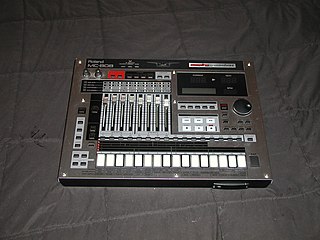
The Roland MC-808 was a groovebox, announced at the Winter NAMM in 2006. It is the successor to the late Roland MC-303, Roland MC-307, Roland MC-505 and Roland MC-909.

The Roland XP-80 is a music workstation that uses digital PCM subtractive synthesis and combines an updated version of the JV-1080 synthesizer engine with the sequencer capabilities of the Roland MRC-Pro sequencer. The XP-80 was introduced in 1996 and is now discontinued.

The SRX are a series of expansion boards produced by Roland Corporation. First introduced in 2000, they are small boards of electronic circuitry with 64MB ROMs containing patches (timbres) and rhythm sets. They are used to expand certain models of Roland synthesizers, music workstations, keyboards, and sound modules.
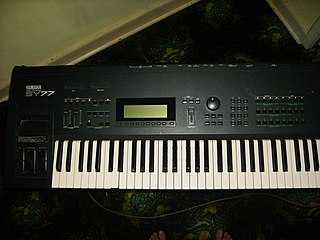
Yamaha SY77 is a 16 voice multitimbral music workstation first produced by Yamaha Corporation in 1989. The SY77 is a synthesizer whose architecture combines AFM synthesis, AWM2 for ROM-borne sample-based synthesis, and the combination of these two methods christened Realtime Convolution and Modulation Synthesis (RCM). The same technology was also packaged in a rack-mounted module released simultaneously, the TG77.
The Roland Alpha Juno series of discontinued keyboards are analog polyphonic synthesizers with a digitally controlled oscillator manufactured by Roland Corporation from 1985 to 1987.

The AX60 is a polyphonic analogue keyboard synthesizer manufactured by Akai Professional in the mid-1980s. It was Akai's answer to the popular Roland Juno series synthesizers. The AX60 uses voltage-controlled analogue oscillators and filter circuitry based on the Curtis Electronics CEM 3394 integrated circuit.
Roland Juno-D is a polyphonic synthesizer introduced in 2005 by Roland Corporation. It is based on the Fantom-X series, having a vintage design that resembles the previous Juno synthesizers, such as the Juno-106. Despite having similar names and introductions, the Juno-D was not intended to be succeeded by the Juno-G synthesizer, for they were both released concurrently. A Limited Edition was released.
Roland Juno-Gi is a music workstation/synth introduced in 2010 by Roland Corporation. As an installment in the long-running Juno series, the synthesizer is the successor to the Juno-G.














